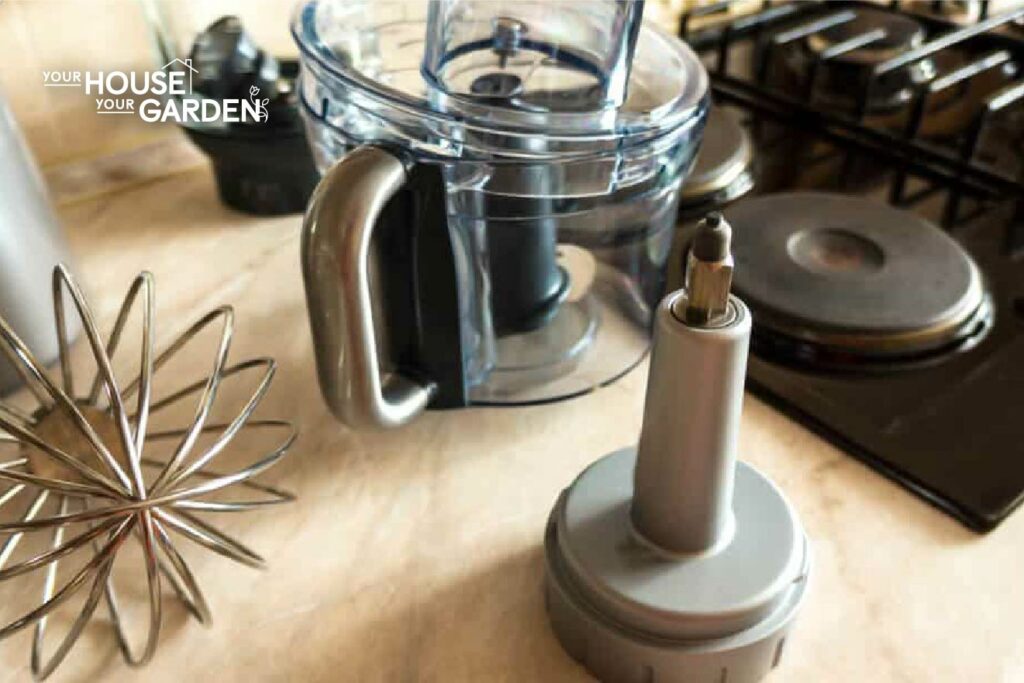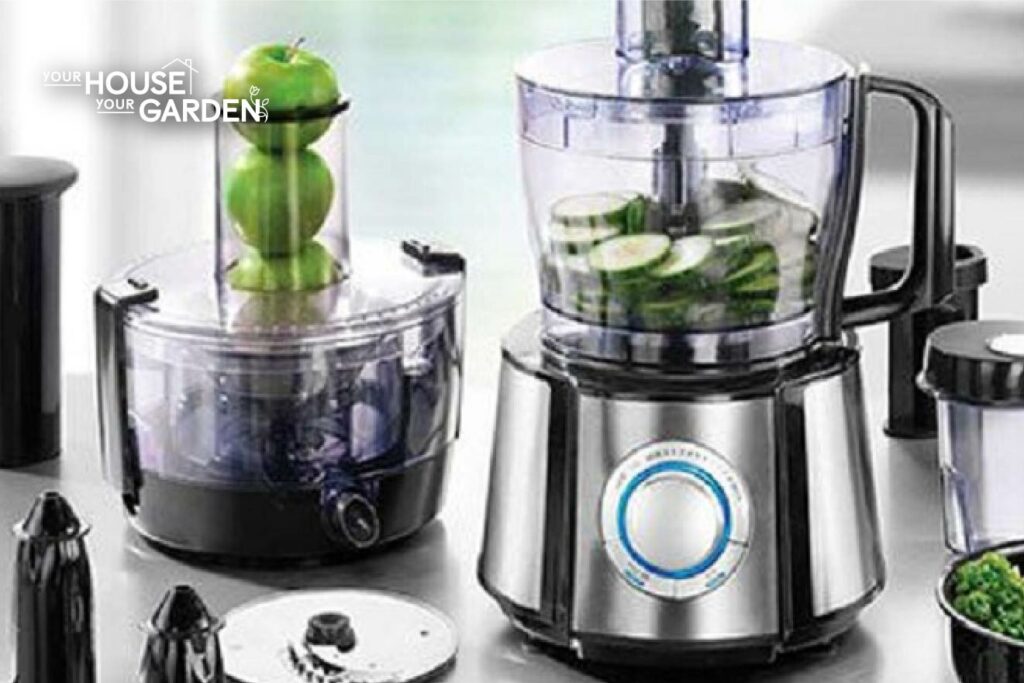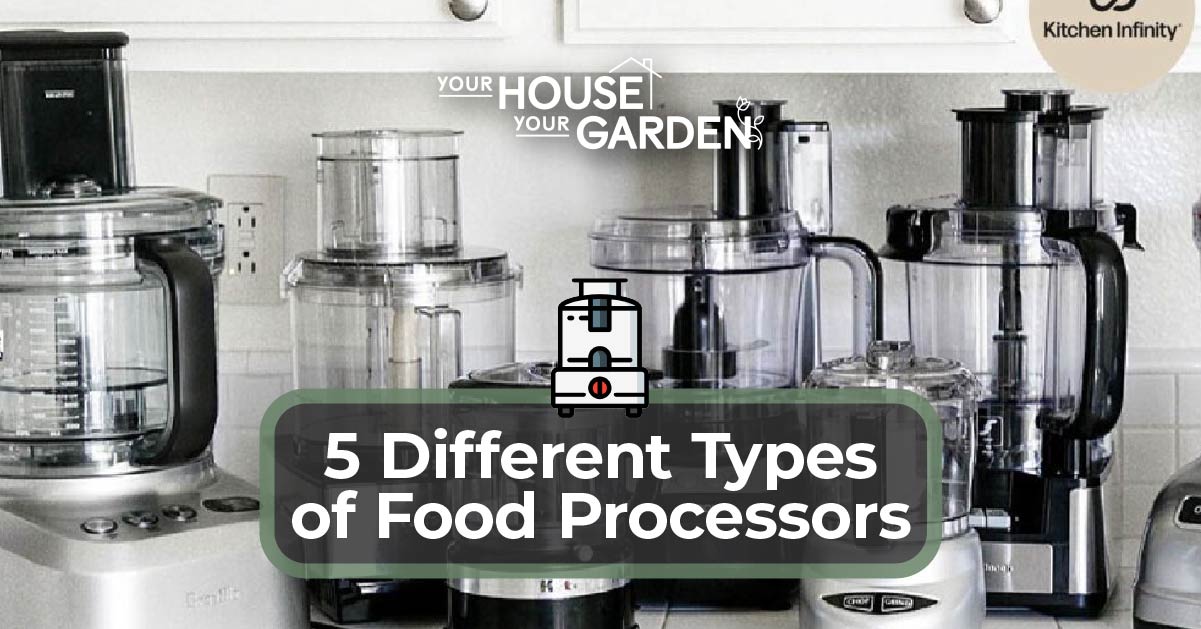There are five different types of food processors on the market today—batch bowl, continuous feed, combination, buffalo chopper, and vertical cutter processor. Each type has its advantages and disadvantages, so it’s essential to understand the differences before purchasing.
Knowing how to use a food processor is also important to gauge whether it’s the right kitchen appliance. For instance, you can decide whether you need a food processor or a chopper by understanding how they work.
In this blog post, we will explore the five types of food processors and discuss the pros and cons of each. We will also help you decide which type of food processor is best for you.
Available types for a food processor
1. Batch bowl food processor
A batch bowl food processor is a type of food processor designed to process large quantities of food at one time. The advantage of this type of food processor over other types is that it can handle more food at once, making it ideal for large families or those who entertain often. However, the disadvantage of this type of food processor is that it is not as versatile as other food processors and can only handle certain types of foods.
2. Continuous feed food processor
A continuous feed food processor is a type of food processor that allows the user to add ingredients while the machine is still running. This food processor is ideal for those who want to make large quantities of food at once or for those who want to add ingredients gradually while the machine is running. Continuous feed food processors typically have a large hopper that can hold a lot of food, and they also usually have a pusher that helps push the food down into the blades. These processors typically have higher power than other types of food processors, and they also tend to be more expensive.
There are several advantages to using a continuous feed food processor. First, it allows the user to add ingredients gradually, which can be helpful when making large quantities of food. It is also typically more powerful than other food processors to handle more demanding tasks.
There are some disadvantages to using a continuous feed food processor as well. First, it can be difficult to add ingredients gradually if the hopper is not large enough. These processors can also be very loud, so they may not be the best choice for those looking for a quiet kitchen appliance. Finally, they may not be the best choice for those on a budget, as they can be expensive.
3. Combination food processor
A combination feed food processor is a type of food processor that can be used for both batch and continuous processing. This type of processor is often used in commercial kitchens because it allows for greater flexibility in terms of processing capacity.
The main advantage of a combination feed food processor is that it can be used for large and small batches of food. This is ideal for kitchens that need to be able to process both large and small quantities of food.
Another advantage of this type of processor is that it generally has a higher capacity than other types. This means that it can accommodate more food at one time, which is ideal for busy kitchens.
The main disadvantage of a combination feed food processor is that it can be more expensive than other processors. This is because it generally has a higher capacity and more features.
If you are looking for a processor that can handle large and small batches of food, then a combination feed food processor is a good option. However, keep in mind that these processors can be more expensive than other types of food processors.
4. Buffalo chopper
A buffalo chopper is a food processor used to chop or grind meat. It is also known as a meat grinder. The main difference between a buffalo chopper and other food processors is that it has a rotating blade that cuts the meat into small pieces.
One advantage of the buffalo chopper is that it can chop meat quickly and efficiently. It is also easy to clean and maintain. Additionally, buffalo choppers are durable and can last many years with proper care.
One disadvantage of using a buffalo chopper is that it is more expensive than other types of food processors. Additionally, it can be challenging to operate and may require some experience to use correctly. Finally, buffalo choppers are not as versatile as other food processors and cannot be used for tasks such as slicing or shredding.
5. Vertical cutter processor
A vertical cutter processor is a type of food processor designed to process large quantities of food at once. Its main advantages over other types of food processors are its speed and efficiency. However, its disadvantages include its size and weight, making it challenging to move around, and its tendency to generate noise.
Different ways to use a food processor
A food processor can be a very versatile kitchen tool—you can use it for anything from chopping vegetables to making breadcrumbs and even some surprising tasks like making homemade peanut butter.
Here are some different ways to use a food processor:
- Chopping vegetables: A food processor is a great way to quickly chop vegetables for salads, soups, or other recipes.
- Making breadcrumbs: Breadcrumbs are a common ingredient in many recipes, and you can easily make your fresh breadcrumbs in a food processor. Add some stale bread to the processor and pulse until you have the desired consistency.
- Making homemade peanut butter: Peanut butter is a popular spread, but did you know you can make your own at home using a food processor? Add some roasted peanuts to the processor and blend until smooth.
- Grinding coffee beans: A food processor is an excellent option for grinding your coffee beans. Pulse the beans until they reach the desired consistency.
- Making dough: A food processor can be used to make dough for pies, pastries, and other baked goods. Add flour, salt, and other ingredients to the processor and pulse until the dough comes together.
As you can see, a food processor can be a very versatile kitchen tool. So if you’re looking for a new kitchen gadget to add to your collection, consider a food processor—you may be surprised at all the different ways you can use it.

Sizes of food processors
Food processors also come in a variety of sizes. The height, width, depth, and capacity can vary depending on the type of food processor.
Here are the specific dimensions and capacity for each type:
Batch bowl processors are the smallest type of food processor, with a capacity of 1.4 liters. They are typically 18 cm tall, 18 cm wide, and 20 cm deep.
Continuous feed processors are larger than batch bowl processors, with a capacity of 3 liters. They are typically 20 cm tall, 22 cm wide, and 25 cm deep.
Combination processors are larger than continuous feed processors, with a capacity of 4 liters. They are typically 22 cm tall, 24 cm wide, and 28 cm deep.
Buffalo choppers are the largest type of food processor, with a capacity of 7 liters. They are typically 24 cm tall, 26 cm wide, and 30 cm deep.
Vertical cutter processors are similar in size to buffalo choppers, with a capacity of 6 liters. They are typically 25 cm tall, 27 cm wide, and 31 cm deep.
Batch bowl food processors vs. continuous feed processors
Batch bowl food processors are the most common type of food processor on the market. They are typically less expensive than continuous feed processors, and they offer a variety of features and options that make them ideal for many home cooks. However, continuous feed processors have some advantages that may make them a better choice for some users.
Here are some pros and cons of either food processor to help you decide which is right for you.
Batch bowl food processors
PROS:
- More affordable than continuous feed processors
- Easier to use and clean
- Offer a variety of features and attachments
CONS:
- Can be less powerful than continuous feed processors
- May not be able to handle large quantities of food as well as a continuous feed processor
Continuous feed processors
PROS:
- More powerful than batch bowl processors
- Can handle large quantities of food more easily
- Ideal for users who want to process large amounts of food at once
CONS:
- More expensive than batch bowl processors
- Can be more challenging to use and clean
- May not have as many features and attachments as a batch bowl processor
So, which type of food processor is right for you?
A continuous feed processor may be the best choice if you want a powerful machine that can handle large quantities of food. However, a batch bowl food processor may be a better option if you are on a budget or only need to process small amounts of food at a time.
What types of food can I process in different food processors?
Different food processors can be used to process different types of food. Some food processors are designed specifically for certain types of food, while others can be used for various foods.
Some common types of food that can be processed with food processors include fruits, vegetables, meats, and cheeses.
Fruits and vegetables can be chopped, pureed, or sliced with a food processor.
Meats can be ground or shredded with a food processor.
Cheeses can be grated or shredded with a food processor.
Some food processors also have attachments that allow them to perform additional functions, such as kneading dough or extruding pasta.
No matter what type of food processor you have, read the manual, so you know how to use your food processor and maximize it in the kitchen.
Criteria for the Best Food Processor Type
When looking for the best food processor for your needs, there are various factors to consider.
When choosing a food processor, it is essential to consider your needs and budget. Full-size food processors are great for large families or those who often entertain, while compact models are more suitable for small households. Be sure to choose a model with the needed features, such as chopping, slicing, and shredding. And finally, pick a food processor with the right power for your needs.
The criteria include:
Size: Full-size food processors usually have a capacity of seven cups or more. They are ideal for large families or if you entertain often. Compact food processors have a capacity of three to five cups and are perfect for small households.
Features: Most food processors have basic features such as chopping, slicing, and shredding. However, some models have additional features such as julienne slicing, pureeing, and dough kneading.
Power: The wattage of a food processor indicates its power. A higher wattage usually means better performance but also a higher price tag.
Price: Food processors range in price from around $30 to $200. The size and features of the food processor will affect the price.
There are various factors to consider when choosing the best food processor for your needs. Be sure to view all of these factors before making your final decision.

Food processor and safety
A food processor can be a safe appliance if proper precautions are taken. However, it is crucial to be aware of the potential hazards of using a food processor and take steps to avoid them.
One hazard of using a food processor is that it can easily cause cuts and other injuries. The blades of the food processor are very sharp and can easily cause cuts if they come into contact with skin. It is essential to be careful when handling the food processor and to keep fingers and other body parts away from the blades.
Another hazard of using a food processor is that it can create a lot of noise. The food processor’s motor can be pretty loud, and this noise can damage hearing if it is not adequately protected. It is important to wear earplugs or other hearing protection when using a food processor.
Food processor and price
Different food processors will have different prices. Some factors that can affect the price include the brand, the size of the food processor, and its features. Generally, food processors range in price from about $30 to $200.
When choosing a food processor, it is essential to consider what you will be using it for. A less expensive model may be sufficient if you only need to do basic tasks like chopping and slicing. However, if you want to do more complex tasks such as making nut butter or bread dough, you will need to choose a more expensive model with more powerful features.
The lifespan of different food processor types
Food processors can last up to 10 years. How long food processors last depends on usage, brand, and model.
The best way to determine how long your food processor will last is to consult the owner’s manual or warranty information. Most food processors can last for a decade with proper care and maintenance.
Food processor types and food processing
The food processor you use will affect the texture of the food you are processing.
Batch bowl processors are the most common type of food processor. They have a fixed bowl with a blade that rotates around the bowl. Batch bowl processors produce more consistent results as the food is chopped evenly by the rotating blade.
Continuous feed processors have a chute that food is fed into and a blade that rotates underneath the chute. The food is chopped as it falls into the bowl below. Continuous feed processors are more likely to produce uneven results as the food falls through the chute at different speeds.
Combination processors have a batch bowl and a continuous feed processor in one unit. Combination processors will have batch and continuous options, so you can choose which type of processing you want for your specific task.
Buffalo choppers are used for larger quantities of food and have a horizontal rotor with two blades that chop the food as it falls through. Buffalo choppers are more likely to produce uneven results as the food falls through the rotor at different speeds.
Vertical cutter processors have a cylindrical drum with a blade that rotates around it. The food is chopped as it falls through the blades and into the bowl below. Vertical cutter processors are more likely to produce even results as the food falls through the blades evenly.
When choosing a food processor, consider what texture you want for your processed food. If you wish to produce consistent results, select a batch bowl processor. Choose a continuous feed or buffalo chopper processor if you want more uneven results. If you wish to get even results, choose a vertical cutter processor.

